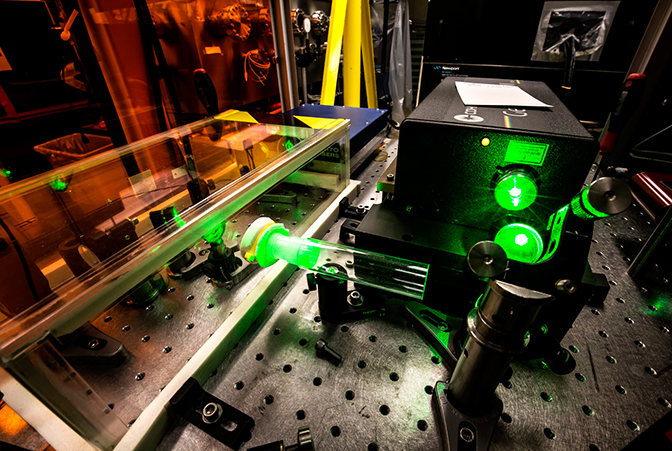
Most powerful laser in the US to be built at Michigan
Using extreme light to explore quantum dynamics, advance medicine and more.

Using extreme light to explore quantum dynamics, advance medicine and more.

The US is upgrading its laser capabilities with ZEUS, a new three-petawatt system to be built at the University of Michigan. Three petawatts is equal to three quadrillion watts, or a 3 followed by 15 zeros.
Funded with $16 million from the National Science Foundation, the facility will enable both basic and applied research. It will test a leading theory on how the universe operates at a subatomic level, and it could lead to advancements in medicine, materials science and national security.
“This laser will have the highest peak power in the United States and will be among the world’s most powerful laser systems for the next decade,” said Karl Krushelnick, the director of the Gérard Mourou Center for Ultrafast Optical Science (CUOS) at U-M, where the laser will be built.
The US built the world’s first petawatt laser in 1996, but we haven’t kept pace with more ambitious systems under construction elsewhere in the world. This includes two 10-petawatt in Europe and a 5.3-petawatt laser in China, which also has plans to build a 100-petawatt laser.
Getting back into the game with a 3-petawatt laser for $16 million is a bargain. The cost savings comes in part from the fact that some high power laser components are now produced commercially, so they don’t need to be custom built. In addition, ZEUS will be an upgrade of an existing 0.5-petawatt laser, known for roughly two decades as HERCULES. The team at CUOS will add an extra amplification stage to increase its peak power.
ZEUS will be what is known as a “user facility,” providing access to extreme laser intensities to scientists and engineers across the country.
“The NSF-supported ZEUS user facility will re-establish the United States as a world leader in high-intensity laser science, as recently recommended by the National Academies,” said Slava Lukin, who directs the NSF plasma physics program. “More than that, it will help advance our understanding of the cosmos by recreating some of the universe’s most energetic light and particle acceleration phenomena in a university laboratory setting.”
One of the signature experiments planned will shoot the laser at a high energy electron beam going the opposite way. This way, researchers will be able to mimic a much more powerful zettawatt laser. (That’s 1 quintillion watts, or a 1 followed by 21 zeros.) With this capability, the U-M team is most excited about the possibility of probing quantum electrodynamics, the reigning explanation of how the universe operates at the subatomic level.
“Quantum electrodynamics is a very successful theory, which has been accurate every time it has been measured in the laboratory,” said Krushelnick. “We hope to explore the more extreme regimes, where there is much more uncertainty in the theoretical predictions.”
For instance, quantum electrodynamics predicts how the high intensities generated with ZEUS could affect the vacuum—essentially the underlying fabric of spacetime. Rather than being simple nothingness, the vacuum does strange things when a very high electric field is concentrated in one location. The pulses from the laser, scattering from the electron beam, should be strong enough to make matter and antimatter—pairs of electrons and positrons—suddenly appear from nothing. This has been called “boiling the vacuum.”
Quantum electrodynamics also predicts that the electric field from the laser could become so strong that it makes the vacuum behave like a lens for light.
In addition to these very fundamental questions, ZEUS could help develop methods and technologies for use in medicine, defense, materials science and astrophysics. Here are some of ZEUS’s potential impacts.
In medicine:
In national security:
In materials science:
In astrophysics:
The funding for ZEUS is part of the NSF’s Mid-Scale Research Infrastructure program. Krushelnick is also a professor of nuclear engineering and radiological sciences, electrical engineering and computer science, and physics.